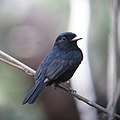| Knipolegus | |
|---|---|
 | |
| White-winged black tyrant near Machu Picchu, Peru | |
| Scientific classification | |
| Kingdom: | Animalia |
| Phylum: | Chordata |
| Class: | Aves |
| Order: | Passeriformes |
| Family: | Tyrannidae |
| Genus: | Knipolegus F. Boie, 1826 |
| Type species | |
| Muscicapa cyanirostris Vieillot, 1818 | |
Knipolegus is a genus of South American birds, the black tyrants, in the tyrant flycatcher family Tyrannidae.
The genus was erected by the German zoologist Friedrich Boie in 1826 with the blue-billed black tyrant as the type species. [1] [2] The genus name combines the Ancient Greek knips meaning "insect" and legō meaning "to pick". [3]












